Typically developing infants will usually learn to transition from prone lying or sitting into prone kneeling (quadruped position) over a period of several weeks.
This experience allows them to acquire the basic strength, coordination, stability and control of balance needed for sustaining the position when they lift one hand to reach for a toy and start to experiment with different ways of moving forwards:
UE strength: ability to support the weight of the upper body with the shoulder in flexion and elbow in extension without locking the elbows into hyperextension.
Trunk and neck muscle strength to maintain stability as the limbs are moved.
UE flexibility: flex the shoulders to about 900 degrees, with the elbow extended and extend the wrists to close on 900 , with the neck in extension and some capital flexion.
HIp flexibility: 90 plus degrees of flexion, along with hip adduction and rotation to neutral.
Coordination required for adjusting weight distribution to maintain balance when the leg or hand are lifted up off the support surface.
Anticipatory postural responses to stabilize the limbs and trunk in readiness for movement of the limbs.
Exploring balance and stability in prone kneeling
This sequence shows Will (6 months) moving from prone to prone kneeling and how he adapts his weight distributions as he works out how to lift his hand to reach for a toy.
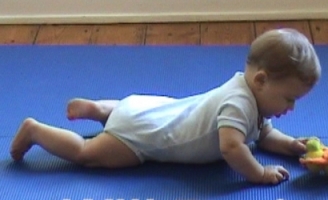

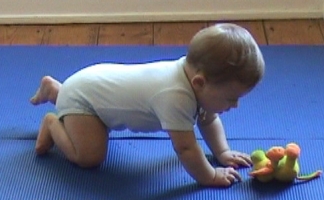

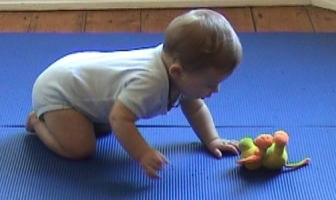



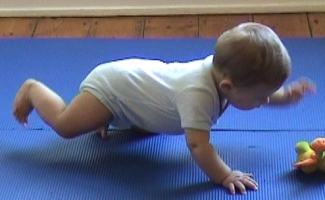
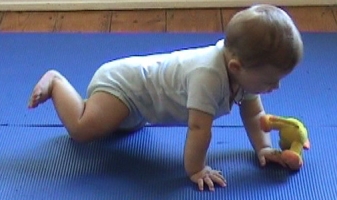
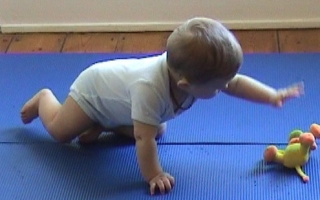
Infants with movement difficulties
Infants with developmental delay, joint hypermobility, Down syndrome and preterm infants often lack the strength, flexibility, coordination and effective balance responses needed for active prone kneeling.
Restricted range of shoulder flexion
Reaching forwards with both UEs requires adequate extensibility of the fascial structures, including the deep fascia, that cross over the upper thoracic regions. This may be associated with the posture of the UE's in supine in preterm birth.
This restriction can be felt when both shoulders are flexed to 900 and then adducted. The restriction may increase if the neck is flexed.

Restricted range of hip adduction
Infants with joint hypermobility, Down syndrome and preterm infants, often have restricted adduction of the hip, when the hip is flexed or extended. The restriction of adduction is usually the result of the habitual posture of the LEs in supine and sitting.


As a result the infant tends to kneel with the hips in abduction, or in abduction combined with lateral rotation. The abduction interferes with the weight shift associated with lifting one hand to reach for a toy, or when crawling.

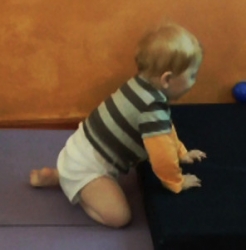
Upper limb strength
Infants who have not spent time actively moving around in prone and pushing up from prone into prone kneeling have not developed the strength needed to support the body weight.
Infants with generalized joint will often lock their elbows into hyperextension when they push into extended arm support. The elbow extensor muscles are minimally engaged and as a result do not develop the strength needed for weight bearing in prone kneeling.
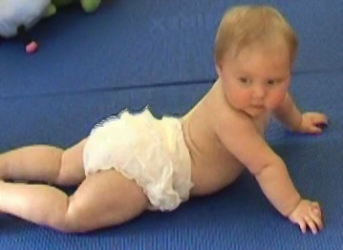
Head and trunk muscle activation and strength
The ability to stabilize the head and trunk in prone kneeling depends on recruitment of right muscles at the right time and in the right direction. This is a matter of task specific coordination rather than just a reflection of muscle strength per se.
Coordination for postural adjustments and stabilization
The coordination needed for maintaining prone kneeling is learned through experience.
Infants who have had limited experience actively moving around in prone have not acquired the basic elements of closed chain actions of the limbs, of using the support surfaces for stability, moving the head and shoulder girdle relative to the pelvis, and the intricate redistribution of weight needed for lifting one are to reach for a toy.
TOMT 0-3 Intervention Strategies For subscribers Subscribe here
Active mobilization of tight hip structures
Training prone kneeling, starting with an adapted physical environment
Training sitting-prone kneeling transitions - using adapted environment
